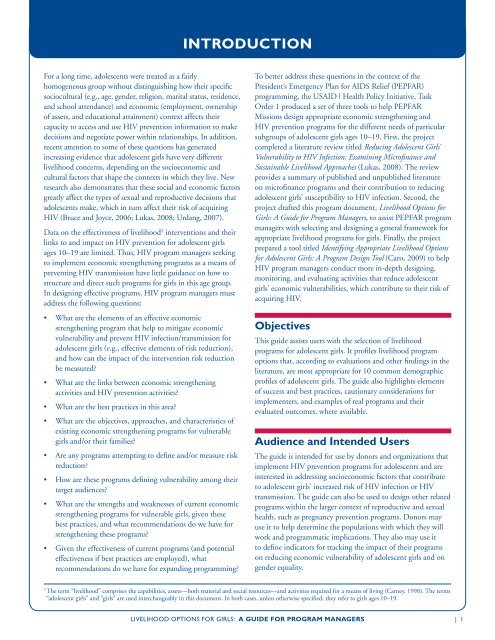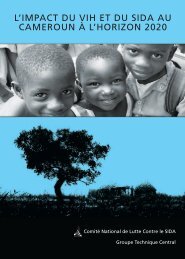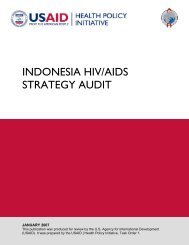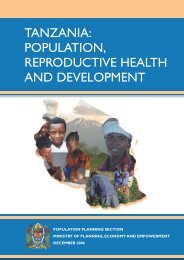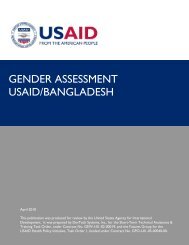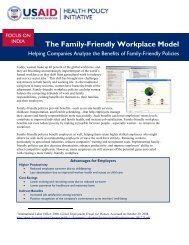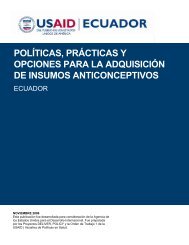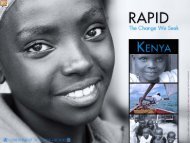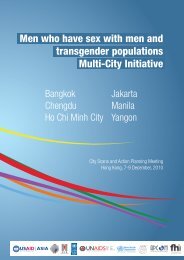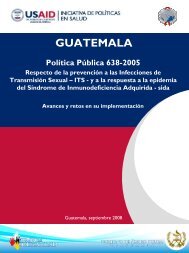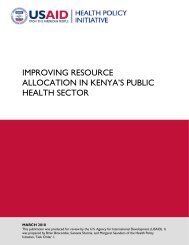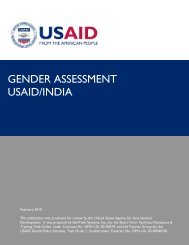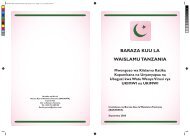LIVELIHOOD OPTIONS FOR GIRLS: - Health Policy Initiative
LIVELIHOOD OPTIONS FOR GIRLS: - Health Policy Initiative
LIVELIHOOD OPTIONS FOR GIRLS: - Health Policy Initiative
- No tags were found...
Create successful ePaper yourself
Turn your PDF publications into a flip-book with our unique Google optimized e-Paper software.
INTRODUCTIONFor a long time, adolescents were treated as a fairlyhomogeneous group without distinguishing how their specificsociocultural (e.g., age, gender, religion, marital status, residence,and school attendance) and economic (employment, ownershipof assets, and educational attainment) context affects theircapacity to access and use HIV prevention information to makedecisions and negotiate power within relationships. In addition,recent attention to some of these questions has generatedincreasing evidence that adolescent girls have very differentlivelihood concerns, depending on the socioeconomic andcultural factors that shape the contexts in which they live. Newresearch also demonstrates that these social and economic factorsgreatly affect the types of sexual and reproductive decisions thatadolescents make, which in turn affect their risk of acquiringHIV (Bruce and Joyce, 2006; Lukas, 2008; Urdang, 2007).Data on the effectiveness of livelihood 2 interventions and theirlinks to and impact on HIV prevention for adolescent girlsages 10–19 are limited. Thus, HIV program managers seekingto implement economic strengthening programs as a means ofpreventing HIV transmission have little guidance on how tostructure and direct such programs for girls in this age group.In designing effective programs, HIV program managers mustaddress the following questions:To better address these questions in the context of thePresident’s Emergency Plan for AIDS Relief (PEPFAR)programming, the USAID | <strong>Health</strong> <strong>Policy</strong> <strong>Initiative</strong>, TaskOrder 1 produced a set of three tools to help PEPFARMissions design appropriate economic strengthening andHIV prevention programs for the different needs of particularsubgroups of adolescent girls ages 10–19. First, the projectcompleted a literature review titled Reducing Adolescent Girls’Vulnerability to HIV Infection: Examining Microfinance andSustainable Livelihood Approaches (Lukas, 2008). The reviewprovides a summary of published and unpublished literatureon microfinance programs and their contribution to reducingadolescent girls’ susceptibility to HIV infection. Second, theproject drafted this program document, Livelihood Options forGirls: A Guide for Program Managers, to assist PEPFAR programmanagers with selecting and designing a general framework forappropriate livelihood programs for girls. Finally, the projectprepared a tool titled Identifying Appropriate Livelihood Optionsfor Adolescent Girls: A Program Design Tool (Caro, 2009) to helpHIV program managers conduct more in-depth designing,monitoring, and evaluating activities that reduce adolescentgirls’ economic vulnerabilities, which contribute to their risk ofacquiring HIV.• What are the elements of an effective economicstrengthening program that help to mitigate economic Objectivesvulnerability and prevent HIV infection/transmission for This guide assists users with the selection of livelihoodadolescent girls (e.g., effective elements of risk reduction), programs for adolescent girls. It profiles livelihood programand how can the impact of the intervention risk reduction options that, according to evaluations and other findings in thebe measured?literature, are most appropriate for 10 common demographic• What are the links between economic strengthening profiles of adolescent girls. The guide also highlights elementsactivities and HIV prevention activities?of success and best practices, cautionary considerations for• What are the best practices in this area?implementers, and examples of real programs and theirevaluated outcomes, where available.• What are the objectives, approaches, and characteristics ofexisting economic strengthening programs for vulnerablegirls and/or their families?Audience and Intended Users• Are any programs attempting to define and/or measure risk The guide is intended for use by donors and organizations thatreduction?implement HIV prevention programs for adolescents and are• How are these programs defining vulnerability among their interested in addressing socioeconomic factors that contributetarget audiences?to adolescent girls’ increased risk of HIV infection or HIVtransmission. The guide can also be used to design other related• What are the strengths and weaknesses of current economic programs within the larger context of reproductive and sexualstrengthening programs for vulnerable girls, given these health, such as pregnancy prevention programs. Donors maybest practices, and what recommendations do we have for use it to help determine the populations with which they willstrengthening these programs?work and programmatic implications. They also may use it• Given the effectiveness of current programs (and potential to define indicators for tracking the impact of their programseffectiveness if best practices are employed), whaton reducing economic vulnerability of adolescent girls and onrecommendations do we have for expanding programming? gender equality.2The term “livelihood” comprises the capabilities, assets—both material and social resources—and activities required for a means of living (Carney, 1998). The terms“adolescent girls” and “girls” are used interchangeably in this document. In both cases, unless otherwise specified, they refer to girls ages 10–19.<strong>LIVELIHOOD</strong> <strong>OPTIONS</strong> <strong>FOR</strong> <strong>GIRLS</strong>: A GUIDE <strong>FOR</strong> PROGRAM MANAGERS | 1


